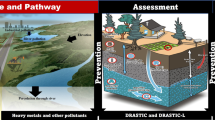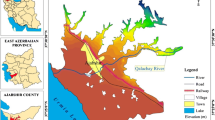Abstract
Delineating areas susceptible to contamination from anthropogenic sources form an important component of sustainable management of groundwater resources. The present research aims at estimating vulnerability of groundwater by application of DRASTIC and Pesticide DRASTIC models in the southern part of the Gangetic plains in the state of Bihar. The DRASTIC and Pesticide DRASTIC models have considered seven parameters viz. depth to water level, net recharge, aquifer material, soil material, topography, impact of vadose zone and hydraulic conductivity. A third model, Pesticide DRASTIC LU has been adopted by adding land use as an additional parameter, to assess its impact on vulnerability zonation. The DRASTIC model indicated two vulnerable categories, moderate and high, while the Pesticide DRASTIC model revealed moderate, high and very high vulnerable categories. Out of the parameters used, depth to water level affected the vulnerability most. The parameter caused least impact was topography in DRASTIC, while in case of Pesticide DRASTIC and Pesticide DRASTIC LU models, the parameter was hydraulic conductivity. A linear regression between groundwater NO3 concentrations and the vulnerability zonation revealed better correlation for Pesticide DRASTIC model, emphasising the effectiveness of the model in assessing groundwater vulnerability in the study region. Considering all three models, the most vulnerable areas were found to be concentrated mainly in two zones, (i) in the south-western part along Ekangarsarai-Islampur patch and (ii) around Biharsharif-Nagarnausa area in the central part. Both zones were characterised by intensive vegetable cultivation with urban areas in between.
















Similar content being viewed by others
References
Ahmed, A. A. (2009). Using generic and Pesticide DRASTIC GIS-based models for vulnerability assessment of the Quaternary aquifer at Sohag, Egypt. Hydrogeology Journal, 17, 1203–1217.
Alam, F., Umar, R., Ahmed, S., & Dar, F. A. (2014). A new model (DRASTIC-LU) for evaluating groundwater vulnerability in parts of central Ganga Plain, India. Arabian Journal of Geoscience, 7, 927–937.
Aller, L., Bennett, T., Lehr, J.H., & Petty, R.J. (1987) DRASTIC: a standardized system for evaluating groundwater pollution potential using hydrogeologic settings. U.S.-EPA/600/2-85/018.
Almsari, M. N. (2008). Assessment of intrinsic vulnerability to contamination for Gaza coastal aquifer, Palestine. Journal Environmental Management, 88, 577–593.
Anane, M., Abidi, B., Lachaal, F., Limam, A., & Jellali, S. (2013). GIS-based DRASTIC, Pesticide DRASTIC and Susceptibility Index (SI): comparative study for evaluation of pollution potential in the Nabeul-Hammamet shallow aquifer Tunisia. Hydrogeology Journal, 21, 715–731.
Babiker, I. S., Mohamed, M. A. A., Hiyama, T., & Kato, K. (2005). A GIS based DRASTIC model for assessing aquifer vulnerability in Kakamigahara Heights Gifu Prefecture, Central Japan. Science of the Total Environment, 345, 127–140.
Bai, L., Wang, Y., & Meng, F. (2012). Application of DRASTIC and extension theory in the groundwater vulnerability evaluation. Water Environment Journal, 26, 381–391.
BIS (2012) Specification for drinking water, ISI: 10500, Bureau of Indian Standards, Second Revision, New Delhi
CGWB (2011) Dynamic groundwater resources of India, Central Ground Water Board, Ministry of Water Resources, Government of India
Chae, G., Kim, K., Yun, S., Kim, K., Kim, S., Choi, B., Kim, H., & Rhee, C. W. (2004). Hydrogeochemistry of alluvial groundwaters in an agricultural area: an implication for groundwater contamination susceptibility. Chemosphere, 55, 369–378.
Chakraborty, D., Das, B., & Murril, M. T. (2011). Examining India’s ground water quality management. Environmental Science and Technology, 45(1), 27–32.
Engel, B. A., Navulur, K. C. S., Cooper, B. S., & Hahn, L. (1996). Estimating groundwater vulnerability to non-point source pollution from nitrates and pesticides on a regional scale. Wallingford, UK: IAHS Publ. no. 235, IAHS.
Foster, S. S. D. (1987) Fundamental concepts in aquifer vulnerability, pollution risk and protection strategy. In W. Van Duijevenboden& H. G.VanWaegeningh (Eds.), Vulnerability of soil and groundwater to pollutants (pp. 69–86). Proceedings and information of the TNO Committee on Hydrogeological Research: Vol. 38. The Hague
Freeze, R. A., & Cherry, A. J. (1979). Groundwater (pp. 262–265). New Jersey: Prentice Hall, Inc.
Ghose, N.C., Saha, D., & Gupta, A. (2009) Synthetic detergents (surfactants) and organochlorine pesticide signatures in surface water and groundwater of Greater Kolkata, India, doi:10.4236/jwarp.2009.14036.
GSI 1998
Gupta, P.K. (2004) Pesticide exposure–Indian Scene. Elsevier Ireland Ltd
Handa, B.K. (1983) Effect of fertilizer on ground water quality in India. In: Symp. On Ground water Development—a perspective for the year 2000 a.d. University of Roorkee, India.
Iqbal, J., Gorai, A. K., Tirkey, P. N., & Pathak, G. (2012). Approaches to groundwater vulnerability to pollution: a literature review. Asian Journal of Water Environment Pollution, 9, 105–115.
Javadi, S., Kavehkar, N., Mousavizadeh, M. H., & Mohammadi, K. (2011a). Modification of DRASTIC model to map groundwater vulnerability to pollution using nitrate measurements in agricultural areas. Journal of Agr Sci Tech, 13(2), 239–249.
Javadi, S., Kavehkar, N., Mohammadi, K., Khodadi, A., & Kahawita, K. (2011b). Calibration DRASTIC using field measurements, sensitivity analysis and statistical method to assess groundwater vulnerability. Water International, 36(6), 719–732.
Jha, M. K., & Sebastian, J. (2005). Vulnerability study of pollution upon shallow groundwater using DRASTIC/GIS. New Delhi: Map India.
Lobo-Ferreira, J. P., & Oliveira, M. M. (2003). On the experience of groundwater vulnerability assessment in Portugal: aquifer vulnerability and risk international workshop AVR03, Salamanca, Gto. Mexico (p. 10). Thailand: Meteorological Department.
McLay, C. D. A., Dragten, R., Sparling, G., & Selvarajah, N. (2001). Predicting groundwater nitrate concentrations in a region of mixed agricultural land use: a comparison of three approaches. Environmental Pollution, 115, 191–204.
Mehta, M. (2006). Status of ground water and policy issues for its sustainable development in India. In B. R. Sharma, K. G. Villholth, & K. D. Sharma (Eds.), Proceedings; ground water research and management, integrating science into management and decisions (pp. 62–74). Colombo: International Water Management Institute.
Merchant, J. W. (1994). GIS-based groundwater pollution hazard assessment: a critical review of the DRASTIC model. Photogramm Engineer and Remote Sensing, 60(9), 1117–1127.
Mukhejee, A., Fryer, A. E., & Howell, P. D. (2007). Regional hydrostratigraphy and ground water flow modeling in the arsenic affected areas of Western Bengal basin; West Bengal. Hydrogeology Journal. doi:10.1007/s10040-007-0208-7.
Napolitano, P., & Fabbri, A.G. (1996) Single-parameters sensitivity analysis for aquifer vulnerability assessmet using DRASTIC and SINTACS. Proceedings of the Vienna conference on HydroGIS96: application of geographic information systems in hydrology and water resources management, IAHS Pub. No. 235, April 1996, p. 559–556.
NBSSLUP. (2003). Soil map of Bihar. Kolkata: National Bureau of Soil Survey and Land UsePlanning. Govt of India, Eastern Region.
Neshat, A., Pradhan, B., Pirasteh, S., & Shafri, H. Z. M. (2013). Estimating groundwater vulnerability to pollution using a modified DRASTIC model in the Kerman agricultural area, Iran. Environmental Earth Science, 71, 3119–3131.
NIUA. (2005). Status of water supply, sanitation and solid waste management in urban areas. New Delhi: National Institute of Urban Affairs.
Rahman, A. (2008). A GIS based DRASTIC mode for assessing groundwater vulnerability in shallow aquifer in Aligarh, India. Applied Geography, 28, 32–53.
Ramos-Leal, J. A., & Rodrı’guez-Castillo, R. (2003). Aquifer vulnerability mapping in the Turbio river valley, Mexico, a validation study. Geofı’ Int, 42, 141–156.
Ribeiro, L. (2000) SI: a new index of aquifer susceptibility to agricultural pollution. Internal report, ER-SHA/CVRM Lisbon Portugal
Rosen, L. (1994) Study of the DRASTIC methodology with the emphasis on Swedish conditions. In: Program and abstracts of the 37th conference of the International Association for Great Lakes Research and Estuarine Research Federation. Buffalo, NY:IAGLR. p. 166.
Saha, D., Upadhyay, S., Dhar, Y. R., & Singh, R. (2007). The aquifer system and evaluation of its hydraulic parameters in parts of South Ganga Plain, Bihar. Journal of the Geological Society of India, 69, 1031–1041.
Saha, D., Dhar, Y. R., & Sikdar, P. K. (2008). Geochemical evolution of groundwater in the Pleistocene aquifers of South Ganga Plain Bihar. Journal Geological Society of India, 71, 473–482.
Saha, D., Dhar, Y. R., & Vittala, S. S. (2010a). Delineation of groundwater development potential zones in parts of marginal Ganga Alluvial Plain in South Bihar, Eastern India. Environmental Monitoring and Assessment. doi:10.1007/s10661-009-0937-2.
Saha, D., Sahu, S., & Chandra, P. C. (2010b). Arsenic safe alternate aquifers and their hydraulic characteristics in contaminated areas of Middle Ganga Plain, Eastern India. Environmental Monitoring and Assessment. doi:10.1007/s10661-010-1535-z.
Saha, D., Dwivedi, S. N., & Singh, R. K. (2013). Aquifer system response to intensive pumping in urban areas of the Gangetic plains, India: the case study of Patna. Environmental Earth Science. doi:10.1007/s12665-013-2577-7.
Sankararamakrishnan, N., Sharma, A. K., & Sanghvi, R. (2005). Orgenochloride and organophosphorous pesticide residues in groundwater and surface water of Kanpur, U.P, India. Environment International. doi:10.1016/J.envint.2004.08.001.
Sankararamakrishnan, N., Sharma, A. K., & Iyenger, L. (2007). Contamination of nitrate and fluoride along the Ganges alluvial plain of Kanpur district, Uttar Pradesh, India. Environ. Moni. Assess. doi:10.1007/s10661-007-0085-5.
Senar, E., & Davraz, A. (2012). Assessment of groundwater vulnerability based on modified DRASTIC model, GIS and analytical hierarchy process (AHP) method; the case of Egiridir Lake Basin (Isparta, Turkey). Hydrogeology Journal, 21, 701–714.
Shirazi, S. M., Imran, M. H., Akib, S., Yusop, Z., & Harun, Z. B. (2013). Groundwater vulnerability assessment in Melaka state of Malaysia using DRASTIC and GIS techniques. Environmental Earth Sciences, 70, 2293–2304. doi:10.1007/s12665-013-2360-9.
Singh, R.K.P. (2011) Changing face of agriculture in Bihar. http://www.bihartimes.in/articles/RKP/agriculture.html
Stigtter, T. Y., Ribeiro, L., & Carvaiho Dill, A. M. M. (2006). Evaluation of an intrinsic and a specific vulnerability assessment method in comparison with groundwater salinization and nitrate contamination levels in two agricultural regions in the south of Portugal. Hydrogeology Journal, 14, 79–99.
Tesoriero, A.J., Inkpen, E. L., & Voss, F. D. (1998) Assessing ground water vulnerability using logistic regression. Proceedings for the Source Water Assessment and Protection 98 conference, Dallas, TX p 157–165
Thapinta, A., & Hudak, P. (2003). Use of geographic information systems for assessing groundwater pollution potential by pesticides in Central Thailand. Environmental International, 29, 87–93.
Umar, R., Ahmed, I., & Alam, F. (2009). Mapping groundwater vulnerable zones using modified DRASTIC approach of an alluvial aquifer in parts of Central Ganga Plain, Western Uttar Pradesh. Journal Geological Society of India, 73, 193–201.
Voudouris, K., Kazakis, N., Polemio, M., & Kareklas, K. (2010). Assessment of intrinsic vulnerability using the DRASTIC model and GIS in the Kiti aquifer, Cyprus. European Water, 30, 13–24. EW Publications.
Vrba, J., & Zeporozec, A. (1994). Guidebook on mapping groundwater vulnerability. International Contributions to Hydrogeology, 16, 129.
Worrall, F., Besien, T., & Kolpin, D. D. (2002). Groundwater vulnerability: interactions of chemical and site properties. The Science of the Total Environment, 299, 131–143.
Zektser, I. S., Karimova, O. A., Bujuoli, J., & Bucci, M. (2004). Regional estimation of fresh groundwater vulnerability: methodological aspects and practical applications. Water Resources, 31(6), 645–650.
Acknowledgements
The research forms a part the PhD thesis of the first author. The authors extend thanks to R.C Jain, K M Najeeb and K C Naik of CGWB for their support. The views expressed by the authors are their own and not of the Department. The discussion made with Rashid Umar, G.K. Roy, R.R. Shukla and S.N. Dwivedi helped in improving the manuscript.
Author information
Authors and Affiliations
Corresponding author
Rights and permissions
About this article
Cite this article
Saha, D., Alam, F. Groundwater vulnerability assessment using DRASTIC and Pesticide DRASTIC models in intense agriculture area of the Gangetic plains, India. Environ Monit Assess 186, 8741–8763 (2014). https://doi.org/10.1007/s10661-014-4041-x
Received:
Accepted:
Published:
Issue Date:
DOI: https://doi.org/10.1007/s10661-014-4041-x




